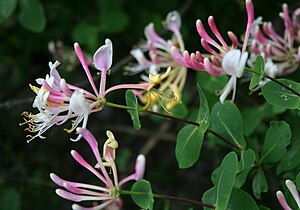Lonicera etrusca: Difference between revisions
From LSJ
Θυσία μεγίστη τῷ θεῷ τό γ' εὐσεβεῖν → Pietate maius nil offertur numini → Das größte Opfer für den Gott ist Frömmigkeit
mNo edit summary |
mNo edit summary |
||
| (5 intermediate revisions by the same user not shown) | |||
| Line 1: | Line 1: | ||
{{lael | {{lael | ||
|lgtx=[[αἰγίνη]] | |lgtx=[[αἰγίνη]], [[περικλύμενον]], [[περικλύμενος]], [[κλύμενον]] | ||
}} | }} | ||
= | {{wkpen | ||
[[File:Lonicera etrusca 3.jpg|thumb|Lonicera etrusca | |wketx=[[File:Lonicera etrusca 3.jpg|thumb|Lonicera etrusca|alt=Lonicera etrusca]] | ||
Lonicera etrusca is a species of honeysuckle known by the common name Etruscan honeysuckle. It is native to Southern Europe, Western Asia and North Africa and it is known elsewhere, including the Pacific Northwest of North America, as an introduced species where it has escaped cultivation. It is kept in gardens as an ornamental plant. | Lonicera etrusca is a species of honeysuckle known by the common name Etruscan honeysuckle. It is native to Southern Europe, Western Asia and North Africa and it is known elsewhere, including the Pacific Northwest of North America, as an introduced species where it has escaped cultivation. It is kept in gardens as an ornamental plant. | ||
= | }} | ||
ar: عسلة توسكانية; bg: етруски нокът; ca: lligabosc etrusc; co: caprifogliu; fa: لنیکرا اتروسکا; fi: etruskikuusama; fr: chèvrefeuille d'étrurie; he: יערה איטלקית; hr: etruščanska kozja krv; ru: жимолость этрусская | {{trml | ||
|trtx=ar: عسلة توسكانية; bg: етруски нокът; ca: lligabosc etrusc; co: caprifogliu; fa: لنیکرا اتروسکا; fi: etruskikuusama; fr: chèvrefeuille d'étrurie; he: יערה איטלקית; hr: etruščanska kozja krv; ru: жимолость этрусская | |||
}} | |||
Latest revision as of 11:35, 24 May 2023
Latin > Greek
αἰγίνη, περικλύμενον, περικλύμενος, κλύμενον
Wikipedia EN
Lonicera etrusca is a species of honeysuckle known by the common name Etruscan honeysuckle. It is native to Southern Europe, Western Asia and North Africa and it is known elsewhere, including the Pacific Northwest of North America, as an introduced species where it has escaped cultivation. It is kept in gardens as an ornamental plant.
Translations
ar: عسلة توسكانية; bg: етруски нокът; ca: lligabosc etrusc; co: caprifogliu; fa: لنیکرا اتروسکا; fi: etruskikuusama; fr: chèvrefeuille d'étrurie; he: יערה איטלקית; hr: etruščanska kozja krv; ru: жимолость этрусская

